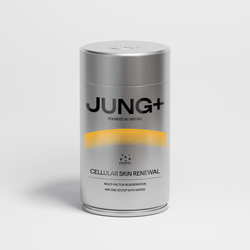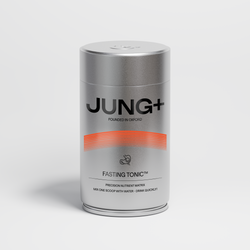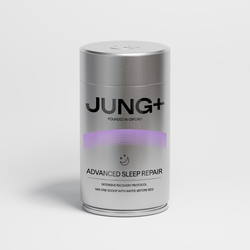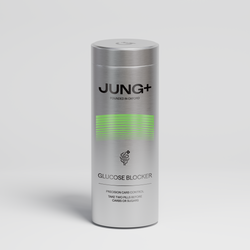
Skin Aging and Longevity: Why Healthy Skin Is a Mirror of Your Health
Have you ever pondered the intricacy and marvel of our skin? It serves as our shield against the external world, safeguarding us from various elements. Additionally, it plays a vital role in preserving our health, longevity, and overall well-being. Let's delve into the profound correlation between healthy skin and general wellness. Discover how luminous skin mirrors your internal health and explore ways to sustain it.
The 12 Hallmarks of Aging: What to Look For & Why They Matter
Summary: The most well-known signs or hallmarks of aging are wrinkles, gray hair, and the number of years lived e.g. chronological age. However, these are more of a visible manifestation of the processes occurring in cells and the body than independent hallmarks. Although we do not fully understand aging, over the last 20 years of research, 12 main hallmarks of aging have been identified, which we will explore here.
The Hallmarks of Aging

Introduction
Historically, for thousands of years, people have used the word "aging," meaning a singular process - getting older. While we still don't fully comprehend aging and all the hidden processes within cells and the body as a whole, we do have tools that allow us to monitor the aging process on a cellular level and exert some influence. These tools are known as the "hallmarks of aging," and they represent a set of discoveries that have significantly advanced the science of longevity [1].
Why is this important? The hallmarks of aging are considered a set of specific partially intertwined mechanisms that can be studied, understood, and influenced to some extent. Imagine the human body as a highly complex automobile, where key parts may experience wear and tear over time. However, by using quality oil, fuel, and regular maintenance checks, we can extend its lifespan.
The originally proposed nine fundamental aspects of aging included telomere attrition, loss of proteostasis, DNA instability, epigenetic alterations, deregulated nutrient sensing, mitochondrial dysfunction, cellular senescence, stem cell exhaustion, and altered intercellular communication. However, recently researchers suggested three additional hallmarks: disabled macroautophagy, chronic inflammation, and microbiota imbalance or dysbiosis [1].
1. Telomere attrition
The term 'telomeres' in biology refers to the end sections of chromosomes (tightly condensed DNA) that prevent them from sticking together, acting as protective caps for the tips of chromosomes. Interest in telomeres in molecular biology arose quite a long time ago, and the scientific field that studies these regions of chromosomes continues to yield surprises.
Telomeres were discovered in the late 1930s, first in flies by Hermann Muller and then in corn by Barbara McClintock. Telomeres gained considerable popularity thanks to the "telomere theory of aging" put forward in 1971 by Alexey Olovinokov. According to this hypothesis, the process of cellular aging is a consequence of incomplete copying of telomeric regions during DNA replication.
However, not always and not everywhere the life cycle of a cell is predetermined by telomeres. There is a mechanism that allows making a cell practically immortal, and its name is telomerase, the existence of which was predicted back in 1974 as an explanation for the absence of aging in some types of cells - both healthy (stem cells) and pathologically altered (e.g., cancer cells). In the 90s, telomerase was discovered, for which a group of scientists were awarded the Nobel Prize in 2009.
Telomerase and telomere dysfunction leads to both a multitude of pathologic conditions, diseases, and aging-related processes such as cellular senescence. Perhaps the best-known disease associated with telomere shortening is pediatric progeria, or Hutchinson-Gilford syndrome. And, of course, when discussing telomeres, we cannot ignore oncologic diseases. In this case, the problem is not too short but too long telomeres. In terms of aging and longevity, telomere attrition is tissue-specific and may depend on environmental factors such as smoking, pollution, obesity, stress, etc [2].
To note, antioxidants such as astaxanthin [3] and niacin [4] could have a protective effect on telomere length by reducing oxidative stress-induced DNA damage. Additionally, supplements like zinc [5], known for their anti-inflammatory and immunomodulatory properties, and astragalus root extract, which can modulate telomerase activity [6], play a role in supporting telomere health.
2. Loss of proteostasis
Proteostasis is one of the most important processes in the body of any creature. Proteins in the body are made up of amino acids, which enter the body with food or are synthesized by cellular molecular machinery. Amino acids are simple and limited in number - there are only 20 of them. But in the course of cellular work, amino acids are put together into proteins, as letters into words, words into sentences, and sentences into paragraphs. If you use the wrong words or ignore grammar, you get nonsense. Similarly, errors in protein folding cause the protein to fail to fulfill its function. If the protein is folded incorrectly, the cell disassembles it down by a special complex called the proteasome to its amino acids and reassembles the protein again.
However, over the course of a lifetime, body tissues accumulate misfolded, oxidized, or otherwise altered proteins that not only fail to perform their functions properly but can form insoluble clumps that disrupt the functioning of entire tissues. Several studies have shown that protein synthesis and related processes generally decline with age in the body. This is caused by an increase in oxidative stress, repressed chaperones (proteins that protect cells from overheating), dysfunction of proteasomes, and the further development of a positive feedback loop: more aggregations -> loss of proteostasis -> more aggregations [7]. Thus, some of the best-known diseases associated with protein stacking disorders are Alzheimer's disease, Parkinson's disease, and amyotrophic lateral sclerosis [8].
It should be noted that the most effective protective treatment against the loss of proteostasis is based on the antioxidant properties of supplements. We have already mentioned niacin [4] as an effective antioxidant in telomere depletion, which is also able to protect proteins from oxidative stress. In addition to it, quercetin [9], fisetin [10], and spermidine [11] are worth mentioning.
3. Epigenetic alterations
Our genes don't work on their own. For the information embedded in DNA to turn into proteins, RNA, and be transmitted to daughter cells, a complex molecular mechanism is required, including the subtle transformation and regulation of all processes. Epigenetic regulation is one of the key stages.
The pillars of epigenetic regulation are DNA methylation, histone modification, chromatin remodeling, non-coding RNA (ncRNA) regulation, and RNA modification. They act like traffic lights and signs on the road, indicating how this process should be regulated. Over time, errors accumulate in the processes of epigenetic regulation - somewhere, the sign is wrong, somewhere it is not there at all, and somewhere it has appeared. These errors affect the vast majority of nuclear processes, including gene transcription and silencing, DNA replication and repair, cell cycle progression, and telomere and centromere structure and function [12].
The epigenome (the totality of all modifications in the whole body) of a cell is dynamic and can be influenced by genetic and environmental factors. Additionally, epigenetic modifications can be reversible, making the gene flexible to respond to environmental changes such as diet, stress, toxicity, physical activity, and medications. Epigenetic changes are correlated with many different diseases: cancer, neurodegenerative diseases, autoimmune diseases, and so on. However, due to the complexity of the diseases, it is not entirely clear whether they are a consequence or a cause [13].
We mentioned earlier that epigenetic modifications are a very flexible process that can be influenced. For example, pterostilbene is a stilbenoid that possesses various properties: it reduces the risk of tumors, protects the body from infections, maintains normal sugar levels, and also lowers cholesterol levels in the blood. By altering DNA methylation and histone modification or modulating microRNA expression, pterostilbene becomes a potent epigenetic modifier [14]. Also of interest are olive leaf extracts (oleuropein) [15] and spermidine [16] due to their involvement in the regulation of epigenetic pillars and transcription - the process of copying a segment of DNA into RNA, which is closely related to the control of epigenetic modifications.
4. Deregulated nutrient sensing
Our metabolism plays a central role in the normal functioning of cells, tissues, organs, and the entire body. The substances we consume and how we consume them primarily affect energy production in our cells, crucial for the many functions they perform. Changes in nutrient availability, excessive cellular activity, and stress can lead to deregulation, causing accelerated aging as cells may not receive the energy or nutrients necessary for proper functioning. Deregulated nutrient perception signifies a failure in the four pathways that regulate metabolism and control energy production [17].
The four pathways that control metabolism are as follows:
- The insulin/IGF-1 pathway is involved in multiple functions essential for metabolism and growth [18].
- The mTOR pathway serves as a key regulator of metabolism and physiology, playing a critical role in the functioning of tissues such as the liver, muscles, brain, and white and brown fat [19].
- Sirtuins, a family of signaling proteins, regulate metabolism and are believed to play a role in longevity [20].
- AMP-activated protein kinase acts as a crucial regulator of cellular energy homeostasis, controlling lipid metabolism, suppressing the formation of fatty acids, cholesterol, and triglycerides. It also regulates the absorption of fatty acids and their breakdown into energy [21].
As we age, oxidative stress, mitochondrial disorders, and disturbances in the functioning of the endoplasmic reticulum (involved in protein folding) increase, accumulating their negative effects and increasingly impacting metabolic processes.
Nevertheless, there are several ways to alleviate the pressure on nutrient sensing. Oxidative stress can be reduced with familiar compounds such as quercetin [9], niacin [4], and spermidine [11]. Olive leaf extract has been shown to activate the AMP-activated protein kinase pathway, inducing autophagy and modulating the sirtuin pathway, particularly SIRT1 [22]. Alongside zinc [23], pterostilbene combats inflammatory processes for reduction [24], while calcium alpha-ketoglutarate is involved in energy production and the metabolism of nutrients [25].
However, deregulated nutrient sensing is highly connected with the next hallmark:
5. Mitochondrial dysfunction
Mitochondria are semi-autonomous organelles within the cell, possessing two membranes and their own hereditary material in the form of a circular DNA molecule. Mitochondrial DNA contains only 37 genes, encoding 13 proteins [26]. Under normal conditions, mitochondria undergo regular renewal, producing controlled amounts of reactive oxygen species and participating in ATP synthesis, the cell's primary energy source.
As aging progresses, several changes affecting mitochondria occur:
- Their total number decreases;
- Their internal structure is disturbed;
- The total amount of mtDNA decreases;
- Various damages accumulate in mtDNA;
- Mitochondrial quality control processes, including mitophagy (removal of damaged mitochondria), biogenesis (formation of new mitochondria), and mitochondrial dynamics, are disturbed [27].
Disruptions in mitochondrial functioning not only impact age-related processes but can also contribute to underlying diseases such as connective tissue disease, rapid fatigue syndrome, glycogenosis, cardiomyopathy, migraine, liver failure, pancytopenia, as well as hypoparathyroidism, diabetes, and rickets. Maintaining mitochondrial health is a crucial factor for overall health and longevity.
Since mitochondria are closely related to oxidative processes in the body, antioxidants play a crucial role in their protection. In addition to those we have already mentioned (niacin, astaxanthin, spermidine), we would like to highlight apigenin. Apigenin is a natural compound classified as a flavone, a type of flavonoid commonly found in various plants and herbs. It possesses antioxidant, anti-inflammatory, and anti-cancer properties. Apigenin is also recognized for its potential to maintain cellular homeostasis, which is the internal balance within a cell that ensures its health and functionality [28].
6. Cellular senescence
In 1961, Leonard Hayflick and Paul Moorhead reported their seminal observation that primary human cells have a finite lifespan in culture, labeling this phenomenon 'senescence at the cellular level.' Senescence is a mechanism that screens out unreliable cells that could become cancerous or any other abnormal cells. An old organism is not made up solely of cells showing signs of cellular senescence, especially cellular morphology changes, growth arrest, and senescence-associated secretory phenotype (SASP); it just has a higher proportion of them [29]. For example, in young mice, the proportion of cells showing signs of senescence is 8%, but in very old individuals, this proportion rises to about 17% [30]. In some organs, such as the heart, skeletal muscles, and kidneys, the proportion of cells with signs of cellular aging does not increase during the lifetime, although these organs undoubtedly function less efficiently with age.
In naked mole-rat, known for their almost complete absence of aging at the organismal level and their resistance to cancer, the cellular senescence system works very actively and efficiently, ruthlessly destroying all cells in which anything suspicious happens [31]. In humans, cells with senescent properties have been shown to increase with age, and moreover, the accumulation of senescent cells is also related to age-associated tissue pathologies such as osteoarthritis, atherosclerosis, and liver cirrhosis [32]. Aging cells often secrete a variety of pro-inflammatory cytokines, chemokines, growth factors, and proteases collectively known as SASPs. SASPs promote inflammation and can affect neighboring cells and thereby initiate their premature aging [33].
7. Stem cell exhaustion
Stem cells, often referred to as the "architects of regeneration". Unlike specialized cells with defined functions, stem cells are undifferentiated and possess the unique capability to transform into a variety of cell types. This inherent flexibility makes them essential for tissue repair, regeneration, and growth.
At the core of their magic lies the process of self-renewal, where stem cells can divide and produce identical copies of themselves. This perpetual self-renewal ensures a constant pool of these versatile cells, ready to respond to the body's needs. Additionally, stem cells can undergo differentiation, evolving into specialized cells such as muscle, bone, nerve, or blood cells, contributing to the repair and replenishment of damaged tissues.
Ideally, stem cells should continuously divide and not age. To achieve this, they possess an enzyme called telomerase, which maintains the length of chromosome ends, preventing DNA shortening after a series of divisions (mentioned in telomere attrition).
Recent discoveries reveal that, during divisions, each new stem cell selectively retains superior cellular components, leaving its sister cell with lesser qualities as it specializes in somatic cells. However, stem cells cannot be entirely shielded from mutations and the accumulation of suboptimal cellular components. Consequently, they undergo aging, although not in the same manner as somatic cells.
Aged stem cells still retain the ability to divide, but the rate becomes suboptimal—either too infrequent or, conversely, too frequent. In the former case, new cells are generated inadequately, unable to fill the vacancies left by the removal of old specialized cells. Conversely, if stem cells divide too frequently, they fail to replenish resources after each division, losing their stem cell characteristics. This depletion reduces the number of functional stem cells in the body, impacting the overall ability to regenerate and renew itself. This process is known as stem cell exhaustion [1].
8. Altered intercellular communication
Cells communicate with each other. Some cells communicate with their nearest neighbors, while others signal to those farther away. Changes in intercellular communication refer to alterations in the way cells exchange information. This can occur through various mechanisms, such as the secretion of signaling molecules, direct cell-to-cell contact, or the transfer of genetic material through extracellular vesicles. These changes in communication can be both a cause and a consequence of aging and disease [34].
Various factors can contribute to such disorders, including the accumulation of errors in DNA, protein folding errors, cell death, and more.
9. Disabled macroautophogy
Disruption of macroautophagy is considered a hallmark of aging due to its role in maintaining cellular homeostasis and proteostasis [35]. Autophagy is a cellular process involving the degradation, destruction, and recycling of proteins and organelles. Fasting has been shown to induce autophagy in various tissues and organs. Its dysfunction can contribute to aging and various diseases such as cancer and neurodegenerative disorders. Autophagic activity tends to decrease with age, leading to a loss of proteostasis and an increase in the number of senescent cells. Additionally, this process is a vicious cycle: oxidative stress, DNA, and protein damage can impair autophagy, and its impairment, in turn, leads to an increase in such damage.
10. Chronic inflammation
One of the latest discoveries in the field of aging is the link between immunity and other signs of aging. As we age, the immune system, responsible for protecting the body from infection and disease, becomes less effective against various pathogens or issues within its own cells, leading to senile pathologies and diseases. The hypothesis suggests that the accumulation of senescent cells with age is associated with a weakening of the immune system's efficiency, indicating an essential role for the immune system in controlling aging. Recent studies not only demonstrate the declining performance of the immune system with age but also reveal its role as a contributor to aging throughout the body. Specifically, aging cells of the immune system can activate senescence in healthy tissues, creating a feedback loop [36, 37]. Senescent cells weaken immunity, and weakened immunity promotes an increase in the number of senescent cells.
Chronic inflammation, persisting over time, contributes to the activation of senescence in cells. To confirm the substantial contribution of the immune system to senescence activation and aging of the whole organism, immune cells from the spleen of eight-month-old transgenic mice and old mice (age 2 years) were transplanted into healthy young mice. One week after transplantation, recipients exhibited a significant increase in the number of senescent cells in both immune system organs and non-lymphoid organs. Additionally, proinflammatory factors associated with cellular aging were detected in the serum, and the lifespan of recipient mice was dramatically shortened [38].
11. Dysbiosis
The human body is a host to billions of diverse microorganisms, including bacteria, fungi, and archaea, residing in different areas such as mucous membranes, skin, and the gastrointestinal tract. This collective of microorganisms is known as the microbiota, with the microbiota of the gastrointestinal tract playing a pivotal role in the body's functioning. The abundance of bacteria residing in our body is astonishing and even overwhelming; these cells surpass our own cells by a factor of ten and harbor at least ten times more DNA than our own genome [39]. However, the majority of them not only pose no harm but are essential. For example, the intestinal microbiota actively participates in digesting certain substances and synthesizing vitamins. Microorganisms also influence the body's immune reactions, and the microbiota can release specific substances that impact the cellular aging process.
Scientists are increasingly suggesting a close connection between the aging process and the intestinal microbiota, considering age-related changes in its composition towards a decrease in species diversity and a decrease in the total number of bacteria as markers of aging. Thus, by appropriately changing the composition of the microbiota, it becomes possible to improve human health. Escherichia coli, a type of microbe that inhabits the human body, produces colanic acid, a substance that appears to “extend the life” of cells. Let's delve into the intriguing nature of this compound.
Under the influence of colanic acid, mitochondria undergo fragmentation, actively dividing and forming new intact organelles. Additionally, these organelles can not only divide but also fuse with each other to create new structures. Mitochondrial fragmentation prevents damaged mitochondria from forming complexes with "healthy" ones. Consequently, with the assistance of colanic acid, the destructive impact on mitochondria is mitigated, contributing to a slowdown in the aging processes [40].
12. DNA instability
Our genetic material, responsible for encoding the instructions needed for cellular functions, can become damaged and altered over time. Several factors contribute to DNA instability, including exposure to environmental toxins, reactive oxygen species, and errors in DNA replication.
As we age, accumulated damage to our DNA can lead to mutations, deletions, and other genomic changes. These alterations not only compromise the integrity of our genetic code but also contribute to the deterioration of cellular functions and the onset of age-related diseases.
One consequence of DNA instability is an increased susceptibility to cancer. Mutations in key genes that regulate cell growth and division can lead to uncontrolled cell proliferation, a hallmark of cancer. Additionally, DNA damage can activate cellular responses that lead to cell senescence or programmed cell death, contributing to tissue degeneration and aging [41].
What does this all mean?
The hallmarks of aging represent interrelated and multifaceted processes that collectively contribute to the aging phenomenon. Addressing these hallmarks requires a holistic approach to the treatment of aging that recognizes the complex connections between various cellular and molecular pathways. In essence, by targeting one hallmark, we can expect to affect several other hallmarks and by targeting all or most of them, we can expect a significant slowdown of the aging process itself.
What can I do about these hallmarks?
Addressing the hallmarks of aging involves a holistic approach to promote overall well-being and longevity. Here are some proactive steps you can take to mitigate the hallmarks of aging:
Specially Formulated Anti-Aging Supplements: Use supplements scientifically formulated with a focus on the hallmarks of aging. Proper supplement regimens may help provide the building blocks for healthy cellular function and support overall longevity.
Regular Exercise: Engage in regular physical activity to promote cardiovascular health, muscle strength, and overall fitness. Exercise has been linked to improved mitochondrial function, reduced inflammation, and enhanced cellular repair processes.
Quality Sleep: Prioritize quality sleep as it plays a crucial role in cellular repair, cognitive function, and overall health. Establishing a consistent sleep routine can contribute to better mood, cognitive performance, and resilience against stressors.
Balanced Nutrition and Healthy Diet: A diverse diet comprising nutritious foods such as vegetables, fruits, and greens, while avoiding junk food, aids the body in combating age-related changes, adopting an inside-out approach.
Intermittent Fasting and Calorie Restriction: Calorie restriction and incorporating intermittent fasting can help achieve healthy cellular processes, including senescence, macroautophagy, and proteostasis and protect cells from oxidative stress.
Manage Blood Sugar Levels: Controlling blood sugar levels plays a key role in anti-aging by influencing various cellular and molecular processes: oxidative stress, inflammation and the formation of glycation end products (AGEs).
Manage stress: A purposeful and meaningful life with low stress levels will help to significantly reduce the processes associated with the negative effects of high cortisol levels on the body. It will reduce oxidative stress, induce proteostasis and improve cellular communication.
Deep Social Relationship With Friends and Family: Social contacts also help reduce stress levels, integrate necessary habits more easily if you feel supported by others, and avoid disruptions in cellular communications.
Every year, the amount of data on the signs of aging increases, revealing the complexity and interconnectedness of processes in cells and the body. What is surprising is our ability to influence these processes, not necessarily to reverse them, but to slow down or delay their onset. This underscores the importance of both studying emerging evidence and using scientifically proven methods to address the hallmarks of aging, including supplements, general preventive tools, and fasting.
- Hallmarks of aging: An expanding universe [2023]. Cell.
- Telomeres, lifestyle, cancer, and aging [2012]. Current Opinion in Clinical Nutrition and Metabolic Care.
- Astaxanthin decreased oxidative stress and inflammation and enhanced immune response in humans [2010]. Nutrition and Metabolism.
- Niacin and Oxidative Stress: A Mini-Review [2016]. Journal of Nutritional Medicine and Diet Care.
- Potential effect of dietary zinc intake on telomere length: A cross-sectional study of US adults [2022]. Frontiers in Nutrition | Nutritional Epidemiology.
- The Use of Natural Agents to Counteract Telomere Shortening: Effects of a Multi-Component Extract of Astragalus mongholicus Bunge and Danazol [2020]. Biomedicines.
- The proteostasis network and its decline in ageing [2019]. Nature Reviews Molecular Cell Biology.
- Proteostasis Failure in Neurodegenerative Diseases: Focus on Oxidative Stress [2020]. Oxidative Medicine and Cellular Longevity.
- Health Benefits of Quercetin in Age-Related Diseases [2022]. Molecules.
- Fisetin as a Senotherapeutic Agent: Biopharmaceutical Properties and Crosstalk between Cell Senescence and Neuroprotection [2022]. Molecules.
- Investigating the Role of Spermidine in a Model System of Alzheimer’s Disease Using Correlative Microscopy and Super-resolution Techniques [2022]. Frontiers in Cell and Developmental Biology.
- Epigenetic regulation of aging: implications for interventions of aging and diseases [2022]. Signal Transduction And Targeted Therapy.
- Role of Epigenetics in Biology and Human Diseases [2016]. Iranian Biomedical Journal.
- Chemoprevention by resveratrol and pterostilbene: Targeting on epigenetic regulation [2018]. Biofactors.
- Oleuropein aglycone protects against pyroglutamylated-3 amyloid-ß toxicity: biochemical, epigenetic and functional correlates [2015]. Neurobiology of Aging.
- The effect of spermine on transcription of mammalian chromatin by mammalian deoxyribonucleic acid-dependent ribonucleic acid polymerase [1975]. Biochemical Journal.
- The Hallmarks of Aging [2013]. Cell.
- Role of insulin/insulin-like growth factor 1 signaling pathway in longevity [2005]. World Journal of Gastroenterology.
- The mechanistic Target of Rapamycin: The grand conducTOR of metabolism and aging [2017]. Cell Metabolism.
- Sirtuins as regulators of metabolism and healthspan [2012]. Nature Reviews Molecular Cell Biology.
- The role of the AMP-activated protein kinase in the regulation of energy homeostasis [2007]. Novartis Foundation Symposia.
- Oleuropein aglycone induces autophagy via the AMPK/mTOR signalling pathway: a mechanistic insight [2015]. Oncotarget.
- Zinc, aging, and immunosenescence: an overview [2015]. Pathobiology of aging and age related diseases.
- Autophagy-inducing effect of pterostilbene: A prospective therapeutic/preventive option for skin diseases [2017]. Journal of food and drug analysis.
- Alpha-Ketoglutarate dietary supplementation to improve health in humans [2022]. Trends in Endocrinology and Metabolism.
- Mitochondrial respiratory-chain diseases [2003]. New England Journal of Medicine.
- The Mitochondrial Basis of Aging and Age-Related Disorders [2017]. Genes (Basel).
- The natural plant flavonoid apigenin is a strong antioxidant that effectively delays peripheral neurodegenerative processes [2019]. Anatomical Science International.
- Cellular senescence: the good, the bad and the unknown [2022]. Nature Reviews Nephrology.
- DNA damage response and cellular senescence in tissues of aging mice [2009]. Aging Cell.
- DNA Homeostasis and Senescence: Lessons from the Naked Mole Rat [2021]. International Journal of Molecular Sciences.
- Senescence at a glance [2013]. Journal of Cell Science.
- Impact of senescence‐associated secretory phenotype and its potential as a therapeutic target for senescence‐associated diseases [2017]. Cancer Science.
- Intercellular communication and aging [2023]. 257-274. In book: Aging.
- Autophagy and the hallmarks of aging [2021]. Ageing Research Reviews.
- Senescence surveillance of pre-malignant hepatocytes limits liver cancer development [2011]. Nature.
- The beginning of the end [2013]. Nature.
- An aged immune system drives senescence and ageing of solid organs [2021]. Nature.
- The human superorganism - of microbes and men [2010]. Medical Hypotheses.
- Gut Microbiome [2015]. Nutrition in Clinical Practice.
- Genomic Instability and Cancer [2014]. Journal of Carcinogenesis and Mutagenesis.
Fibroblasts: The Unsung Heroes of Skin Anti-Aging
The Truth About Collagen Supplements
It's no secret that all multicellular organisms are made up of cells. But what many people don't realize is what surrounds those cells. Often, cells in an organism are mistakenly thought of as densely packed bricks firmly cemented together. In fact, cells are kept in a relatively constant position from each other by the extracellular matrix. The substances of which it is composed can be divided into several groups: glycoproteins, proteoglycans, and hyaluronic acid. The glycoprotein called collagen should be emphasized because it is the most common protein not only in the extracellular matrix but also in the entire human body. Let’s talk about it!
Topical creams for anti-aging (and why they don't work). A longevity medicine perspective
To smear or not to smear, that is the question. We are accustomed to believing that the promise of eternal youth is easily attainable by using the right face cream—you just need to buy that coveted jar. Society invests hundreds of millions of dollars in the pursuit of youthful, firm, and elastic skin, and cosmetic companies continually develop new formulas, each claiming to be more effective than its predecessors in order to retain customers and boost profits. But do creams truly live up to their promises, or is there an underlying issue?
The billion-dollar anti-aging cream industry
The billion-dollar anti-aging cream industry is a testament to the widespread desire for youthful, glowing skin. Fueled by the relentless pursuit of conquering time, this thriving sector offers a range of products that promise to combat the obvious effects of aging. From high-end luxury brands to affordable drugstores, the industry caters to a diverse audience seeking an elixir of timeless beauty. Marketing campaigns exaggerate the effectiveness of anti-aging creams, thereby trying to attract more and more customers. The aggressiveness of advertising is heightened by influencers and bloggers who actively use app filters and photoshop to enhance the "product effect."
Skepticism also arises, to a lesser extent, from how consumers grapple with the "expectation-reality" difference that constantly emerges when using anti-aging creams; and the main factors, such as biological age, the cause of aging, genetic predisposition, and various skin diseases, often get overshadowed.
Ultimately, a critical question arises: Can these anti-aging creams truly defy time, or are they a complex mixture of wishful thinking, science, and marketing?
How do anti-aging creams claim to work?
Anti-aging creams often recommend considering various active ingredients designed to address the limitations of aging. They prioritize hydration to diminish the appearance of fine lines and wrinkles. Ingredients like hyaluronic acid and glycerin are commonly added to enhance skin moisture. In this case, glycerin primarily retains skin moisture by creating a surface film that prevents evaporation. Hyaluronic acid, a popular topical ingredient, cannot penetrate the skin due to its larger molecules, which are 2-4 times bigger than those absorbable by the skin [1].
Some creams focus on compounds that stimulate antioxidant defenses. Vitamins C and E, green tea extract, and coenzyme Q10 are examples of antioxidants believed to shield the skin from environmental stress. However, applied topically, these ingredients cannot penetrate deeply into the skin to actively combat the causes of age-related changes. Additionally, vitamin C, for instance, is quickly destroyed when heated, so if the cream is stored in a warm place, its effectiveness is significantly reduced.
None of these ingredients or compounds can significantly affect the root cause of skin aging or the associated damage, neither slowing it down nor stopping it.
Symptoms versus causes of skin aging
Understanding the symptoms and causes of skin aging is essential for developing effective and targeted skincare. However, the industry's original strategy was to solely target the symptoms of aging: wrinkles, uneven skin tone, dehydration/dryness, and thinning skin, conforming to the existing cosmetic mold.
This was partly due to a lack of scientific knowledge in the field of aging and skin aging particularly. For instance, the first creams appeared in 1983, and the concept of telomere attrition was formulated in the 90s, and was later awarded the Nobel Prize [2]. On the other hand, driven by a thirst for profit, companies harbored the illusion that in-depth, long-term research was actively exploring the cause-and-effect relationships between processes and their evident impact on the skin. Science has made significant strides over the past decades, paralleled by increased consumer awareness of the products they purchase.
This approach originated from a lack of scientific knowledge in the field of aging and specifically skin aging, leading companies to concentrate on surface-level manifestations rather than exploring the root causes. For instance, the first creams emerged in 1983, while the concept of telomere depletion, a key aspect of aging, was only formulated in the '90s and later received a Nobel Prize [2].
The cosmetics industry's initial oversight was driven by profit motives and misconceptions about the processes in the skin that cause age-related changes. In essence, the cosmetics industry had limited understanding of geroscience. However, the situation has significantly changed in recent decades as scientific advancements have been made, and consumers have become more discerning about the products they purchase. Yet, companies continue to operate by inertia, incorporating new scientific discoveries but without significant changes in the concept of their products and marketing.
To propel skincare into a new era, there is a need to integrate the principles of longevity science. This perspective underscores the multifactorial nature of aging, emphasizing research into the 12 hallmarks of aging that closely correlate with fibroblast (and other skin cells) aging processes associated with DNA damage and oxidative stress. Understanding these processes is crucial, as fibroblasts, the remarkable skin cells responsible for collagen and elastin production, become less active, contributing to the recognizable signs of aging. Applying collagen topically has limited effectiveness, as anti-aging creams have minimal impact on fibroblasts. The cosmetic industry often overlooks the significance of acting internally on causes of aging: molecular mechanisms, cellular senescence, and energy source depletion, instead offering creams as a panacea for everything at once.
Aging is a complex and multifaceted process that necessitates a comprehensive approach. It is essential to influence not only the outcomes of aging but also the numerous aging processes themselves.
How skin evolved to protect against topical products
Over millions of years, the evolution of skin has been a remarkable process dedicated to crafting a robust and efficient barrier against the external environment. This evolutionary journey has bestowed upon us a tool equipped with layers and mechanisms to repel harmful elements, pathogens, and environmental stressors.
The outermost layer, the epidermis, functions like a formidable shield, thwarting germs, toxins, and other threats from infiltrating the body. Over time, the epidermis has evolved into a sophisticated structure with various sublayers, each serving a specific protective function against external aggressors. Keratocytes (skin cells) form tight cellular contacts with each other, greatly limiting the size of compounds that can penetrate deep into the skin. The molecular weight of compounds capable of penetrating the skin is believed to be less than 500 Daltons [1]. For comparison, a hyaluronic acid molecule typically ranges from 600 to 12,000 Daltons [3], peptides over 5 amino acids range from 800 Daltons, enzymes from 20,000 Daltons, and collagen and elastin are even larger at 120,000 Daltons! Due to this weight, all the mentioned cream ingredients cannot penetrate the skin, and they will simply be washed away. In contrast, substances like retinol, small peptides, and certain acids can achieve this feat. However, due to the skin's layered structure, their penetration is still limited to the surface.
At the same time, the skin has developed its own ability to regulate moisture and hydration levels, preventing excess evaporation and/or exposure to moisture from the outside. This adaptation is crucial for the overall health and resilience of the skin.
The science (or lack thereof) behind common topical anti-aging ingredients
Skin care products are flooded with claims to reverse the effects of aging, each boasting a myriad of ingredients promising youthful skin. However, the scientific basis for these ingredients varies, and some claims lack solid scientific backing. Skincare products often claim to reverse the aging process, each presenting an array of enticing ingredients for youthful skin. Luxurious anti-aging cosmetics, for instance, incorporate gold nanoparticles for their anti-inflammatory and antifungal effects, enhancing skin permeability to other cream components.
Furthermore, ingredients like salmon oil for nutrition, snail extract for skin renewal, and snake venom as a Botox alternative are actively featured in anti-aging creams. However, the direct connection of these ingredients to scientifically proven anti-aging properties remains unclear. Additionally, various components aim at promoting radiant skin, often amplified by light-reflecting particles.
While such formulations may contribute to daily skincare, their actual anti-aging efficacy raises questions. Companies sometimes incorporate unique ingredients not solely for their properties but rather for their distinctiveness in the market. Therefore, it is crucial to critically assess formulations to identify truly effective ingredients.
The limitations and potential risks of topical creams
Topical creams have become ubiquitous; however, it is important to recognize the limits and potential risks associated with their daily use.
One of the main limitations is that topical creams primarily work on the surface of the skin and cannot penetrate deep enough to address underlying problems. While they may provide temporary improvements in hydration, texture, and the appearance of fine lines and wrinkles, their effects are often nonspecific. Additionally, the effectiveness of topical creams may vary depending on individual skin type, condition, and genetics [4].
To note, skin hosts a diverse collection of microorganisms - the skin microbiome - functioning in unison to safeguard the skin. They protect against harmful pathogens, balance pH, support natural defenses, and help retain optimal hydration. Disruption in this microbial harmony can lead to skin conditions like acne, eczema, and rosacea. Regrettably, numerous topical skin products can disrupt or harm this microbial balance, inadvertently impairing skin longevity [5].
Potential risks associated with topical creams include skin irritation, adverse effects, or negative interactions with other products. Harsh ingredients or improper use can cause skin problems or create new ones.
The few topical products that actually work
Despite the limitations and risks associated with using topical creams, certain compounds can indeed have a positive impact on skin health and longevity. For instance, ceramides play a vital role in safeguarding the integrity of the skin barrier and contribute significantly to the formation of a healthy skin microbiome. By fortifying the skin barrier, ceramides create an environment conducive to the flourishing of beneficial microorganisms, ensuring their balanced coexistence [6]. Additionally, niacinamide, known for its potent antimicrobial properties, helps maintain a healthy composition of skin microorganisms. It regulates sebum production, establishing an environment that fosters the growth of beneficial microbes while restricting harmful bacteria [7].
As mentioned earlier, some compounds can penetrate the skin. For example, retinol, pure vitamin A, is an active and highly effective component with a proven impact on the skin. Due to its small size, retinol can penetrate into the deep layers of the skin. It binds to retinoic acid receptors (RARs) in the cell nucleus, leading to the regulation of gene transcription and influencing various physiological pathways in the skin [8]. Retinol stimulates the proliferation of keratinocytes and endothelial cells, activates dermal fibroblasts to synthesize extracellular matrix proteins, and enhances the adhesion of endothelial cells and leukocytes [9, 10]. It accelerates the exfoliation of old and damaged skin cells, allowing new and healthier cells to replace them. Additionally, retinol exhibits antioxidant properties and can modulate the expression of genes involved in cell migration, adaptive immune activation, inflammation, and matrix reorganization [8].
An inside-out approach to skin aging
Nutrition and the use of various high-quality supplements play a more crucial role in maintaining longevity than the use of anti-aging creams. The skin, although a barrier, like all organs, receives nutrients from what we eat. A well-balanced diet rich in vitamins, antioxidants, and essential micronutrients plays a vital role in maintaining the integrity of the skin. Foods such as fruits, vegetables, whole grains, and lean proteins provide the necessary building blocks for healthy skin cells and collagen production.
More importantly, the use of vitamins and supplements is more effective than topical application and diets. Addressing the complexity of aging necessitates a comprehensive approach. While no single supplement can halt the aging process, a combination of several supplements may offer a solution that addresses various aspects. For example, the active collagen peptides found in Cellular Skin Renewal have been scientifically proven to significantly boost collagen production in skin. The antioxidants in the formula protect fibroblasts and new collagen fibers from oxidative damage caused by stress, pollution, and other factors. Additionally, maintaining adequate hydration is equally important, as water is essential for preserving skin elasticity and a radiant complexion, and supplements like Cellular Skin Renewal contain hyaluronic acid.
While diet and lifestyle play a role, consider how many oranges you'd need to eat to achieve the necessary vitamin C levels. Don't forget about allergies, the cost of the fruit, and the need to consume them daily. Quality supplements with scientifically proven formulas can ensure both the health and longevity of your skin.
Making informed decisions in the anti-aging market
In the vast and ever-expanding anti-aging market, making informed decisions is critical for individuals seeking effective solutions to maintain youthful, healthy skin. With an industry promoting a large number of products promising to speed up or slow down the aging process, consumers have many options to choose from. It is important to consciously approach the choice of certain products.
Different species may respond differently to different ingredients, and tailoring to specific needs is a necessary first step. Consulting a dermatologist or skincare specialist can provide personalized information on the most suitable products or treatments. But be smart! Oftentimes these specialists have more training in appearance than underlying causes and mechanisms of aging. A careful examination of ingredients helps identify potential allergens, irritants, or ingredients that may affect individual skin conditions. It is equally important to recognize the boundaries and potential risks associated with commitments or procedures. Make informed decisions!
So, go ahead and apply the cream. However, relying solely on a good cream, no matter how effective, may not be sufficient to achieve the desired results. It's crucial to adopt an inside-out approach—incorporate nutritional supplements to support fibroblasts, maintain collagen levels, reduce oxidative stress and daily stress, and ensure proper sleep and hydration. Only through a comprehensive approach can you effectively maintain youthful and healthy skin.
- The 500 Dalton rule for the skin penetration of chemical compounds and drugs [2000]. Experimental Dermatology.
- The Nobel Prize in Physiology or Medicine [2009]. Available from: https://www.nobelprize.org/prizes/medicine/2009/illustrated-information/
- Benefits of topical hyaluronic acid for skin quality and signs of skin aging: From literature review to clinical evidence [2022]. Dermatologic Therapy.
- Personalized skincare: from molecular basis to clinical and commercial applications [2018]. Clinical, Cosmetic and Investigational Dermatology.
- Human Skin Microbiome: Impact of Intrinsic and Extrinsic Factors on Skin Microbiota [2021]. Microorganisms.
- Commensal Staphylococcus epidermidis contributes to skin barrier homeostasis by generating protective ceramides [2022]. Cell Host & Microbe.
- Mechanistic Basis and Clinical Evidence for the Applications of Nicotinamide (Niacinamide) to Control Skin Aging and Pigmentation [2021]. Antioxidants.
- Retinoids in the treatment of skin aging: an overview of clinical efficacy and safety [2006]. Clinical interventions in aging.
- Update: Mechanisms of Topical Retinoids in Acne [2022]. Journal of Drugs in Dermatology.
- Topical retinol attenuates stress-induced ageing signs in human skin ex vivo, throughEGFR activation viaEGF, but notERK andAP-1 activation [2019]. Experimental Dermatology.















you, like new
you, like new
you, like new
you, like new
you, like new
you, like new
you, like new
you, like new
you, like new
you, like new
you, like new
you, like new
you, like new
you, like new
you, like new
you, like new
you, like new
you, like new
you, like new
you, like new
you, like new
you, like new
you, like new
you, like new
you, like new
you, like new
you, like new
you, like new
you, like new
you, like new

Get the latest from Jung+
All journal entries

Topical creams for anti-aging (and why they don...
To smear or not to smear, that is the question. We are accustomed to believing that the promise of eternal...
Topical creams for anti-aging (and why they don...
To smear or not to smear, that is the question. We are accustomed to believing that the promise of eternal...

The Truth About Collagen Supplements
It's no secret that all multicellular organisms are made up of cells. But what many people don't realize is what...
The Truth About Collagen Supplements
It's no secret that all multicellular organisms are made up of cells. But what many people don't realize is what...

Fibroblasts: The Unsung Heroes of Skin Anti-Aging
If your skin is a country, fibroblasts are royalty! Cells that many people don't know about, cells that are not...
Fibroblasts: The Unsung Heroes of Skin Anti-Aging
If your skin is a country, fibroblasts are royalty! Cells that many people don't know about, cells that are not...

Skin Aging and Longevity: Why Healthy Skin Is a...
Have you ever pondered the intricacy and marvel of our skin? It serves as our shield against the external world,...
Skin Aging and Longevity: Why Healthy Skin Is a...
Have you ever pondered the intricacy and marvel of our skin? It serves as our shield against the external world,...

The 12 Hallmarks of Aging: What to Look For & W...
Summary: The most well-known signs or hallmarks of aging are wrinkles, gray hair, and the number of years lived...
The 12 Hallmarks of Aging: What to Look For & W...
Summary: The most well-known signs or hallmarks of aging are wrinkles, gray hair, and the number of years lived...








